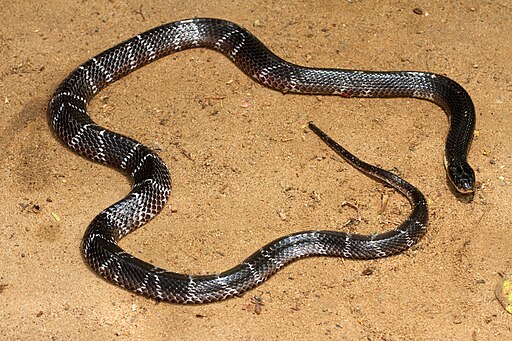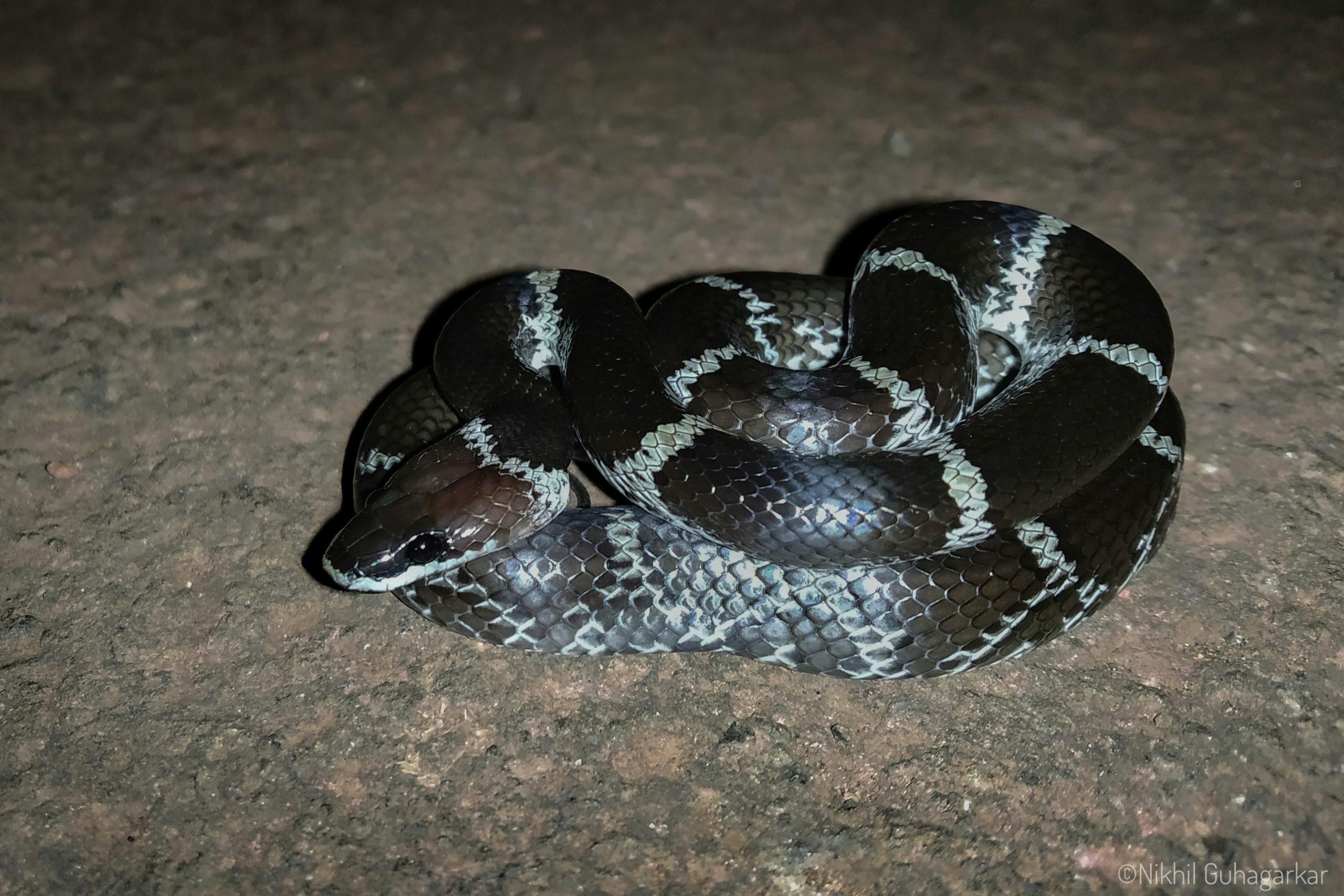~ by Omkar Hande
This blog post has been published as part of the ‘Nature-based Solutions for Sustainable Rural Landscapes and Climate Resilience‘ programme supported by HSBC Software Development (India) Private Limited.
This incident is from the picturesque village of Purushwadi, nestled among the majestic Sahyadri mountain range in Maharashtra. It was the peak of summer and we, from the Biodiversity and Ecology team of W-CReS, had arrived to collect pre-monsoon seasonal biodiversity data from this tribal village, situated in the Akole Block of Ahmednagar district in Maharashtra.
Purushwadi, with its untouched natural beauty, offers a glimpse into rural life and traditional culture. The villagers rely on agriculture and sustainable farming methods to make a living. At this time of the year, their fields were adorned with crops like rice, wheat, millet, and pulses, thriving under the care of diligent farmers.
But Purushwadi has more to offer than just thriving crops. It is famous for its annual firefly festival, held during the monsoon season in June and July. The festival draws visitors from all over the world who marvel at the enchanting sight of thousands of fireflies illuminating the forests and fields. The village is bathed in a soft, mystical glow, creating a truly magical experience for all who witness it. Visitors not only enjoy learning about traditional farming practices and savoring authentic local cuisine but also have the opportunity to engage in hands-on farming activities.
The village’s proximity to the Kalsubai Harishchandragad Wildlife Sanctuary means that encounters with wildlife are not uncommon. The villagers have often reported leopard sightings, leading to occasional conflicts between humans and wildlife.
We were thrilled at the prospect of spotting a leopard in its natural habitat. Finally, on May 14th, our excitement reached its peak when we heard the unmistakable roar of a leopard coming from the nearby sugarcane field. The house owner, sensing danger, quickly ushered us inside. The realisation that in that wild paradise we were not alone was a sobering one. After a late-night discussion on stories of previous leopard encounters, we eventually retired to bed.
The next morning, while it was still dark, a cry rang out: “पडवी मधे मोठा साप आहे” (“There is a big snake in the store/kitchen room“). It was the house owner’s wife, who had woken up early to prepare food for us, as she did every day. On this particular morning, however, her routine was interrupted by an unwelcome guest. She had stumbled upon a snake and rushed to alert the others.
Half-awake and guided by the beam of a torch, we hurried to the kitchen. There, we witnessed a terrifying scene—a black snake with a chick in its mouth and a hen a few feet away, fighting for its life. It was a deadly and highly venomous common krait, locally known as Manyaar.

The Common Krait
The common krait (Bungarus caeruleus), also known as the Bengal krait, is a member of the “big four” venomous snakes in India, is slender, bluish black to dark brown in color, with smooth, glossy scales. The head is black, while the lower lip and underside are white. Measuring an average length of 100 cm (3ft 3in), the common krait primarily preys on other snakes, including its own kind. Its venom contains potent neurotoxins that cause muscular paralysis. It occasionally also consumes mice, frogs, lizards and other small animals. The common krait is a nocturnal creature, shy in nature, and can be found in forests, near human habitation, paddy fields, and even arid and rocky areas.

Interestingly, the common krait is connected to the Indian or common wolf snake through a phenomenon called Batesian mimicry. The Indian wolf snake, a harmless non-venomous species, is found throughout India and often encounters are mistaken for the common krait due to their striking resemblance. The Indian or common wolf snake derives its name from its long, sharp front teeth, reminiscent of a wolf’s. This resemblance to the venomous common krait serves as a survival strategy, allowing the harmless snake to imitate the warning signs of India’s most dangerous snakes, thus deterring potential predators.

(Lycodon aulicus)
In the midst of this captivating encounter with the common krait, the house owner reached for a stick, intending to kill the snake. However, being familiar with such situations, I stepped in and urged a different course of action. “We must rescue this creature,” I insisted. To my relief, the owner relented to my plea and inquired about my plan.
I requested a plastic container to safely secure the snake which the owner quickly fetched. Wearing strong field shoes, I carefully approached the snake. My confidence stemmed from the fact that the snake had its mouth full with the chick, making it less likely to bite. I gently touched the snake’s tail and placed the plastic container in front of its mouth.
After a few failed attempts, the common krait was safely captured inside the container. With the snake now secured, we ventured far from the village to release it back into its natural habitat.
Both the tribal community and we understood the importance of every creature’s role in the ecosystem and believed in promoting harmony between humans and nature.
As the sun rose higher in the sky, casting its warm light upon the village of Purushwadi, we continued our mission, collecting valuable data on the region’s biodiversity. Our hearts filled with gratitude for the opportunity to witness nature’s marvels and our minds brimming with newfound knowledge, we pressed on, eager to contribute to the conservation of Purushwadi’s unique ecosystem and the well-being of its inhabitants. Each encounter, whether with fireflies illuminating the night sky or the sight of a deadly common krait, served as a reminder of the wonders and interconnectedness of the natural world.
WOTR and W-CReS are implementing an Ecosystem-based adaptation (EbA) project in the tribal areas surrounding Purushwadi. The project’s goal is to educate the community about the significance of the surrounding ecosystem and how they could coexist with nature in a sustainable manner. Biodiversity and ecosystem services play vital roles in this project, and small acts like rescuing a snake go a long way in building trust and understanding with the local community.
Further Readings
- Lohakare, Tejaswee et al. 2022. “A Life-Threatening Incidence of Neurotoxic Indian Krait Snake Bite: A Case Report.” Cureus 14(8): e27719.
- Upasani, Manali Sughosh et al. 2018. “Infrequent Use of Medicinal Plants from India in Snakebite Treatment.” Integrative Medicine Research 7(1): 9–26. https://www.sciencedirect.com/science/article/pii/S2213422017301014.
- Come June Enjoy the Incredible Purushwadi Firefly Festival





